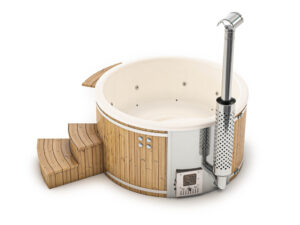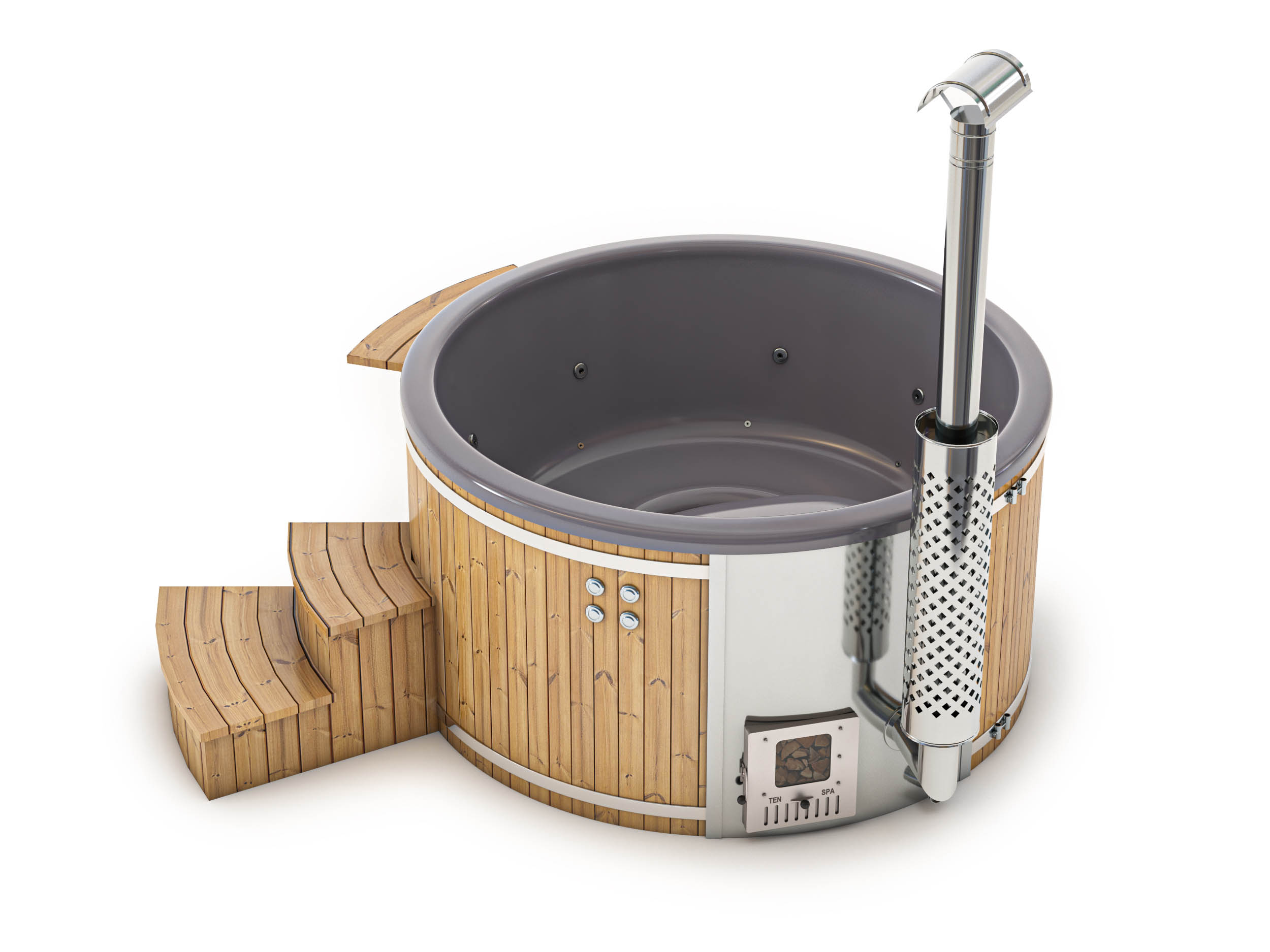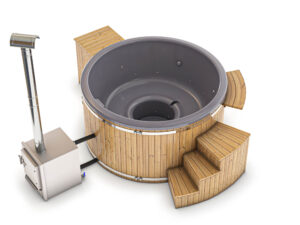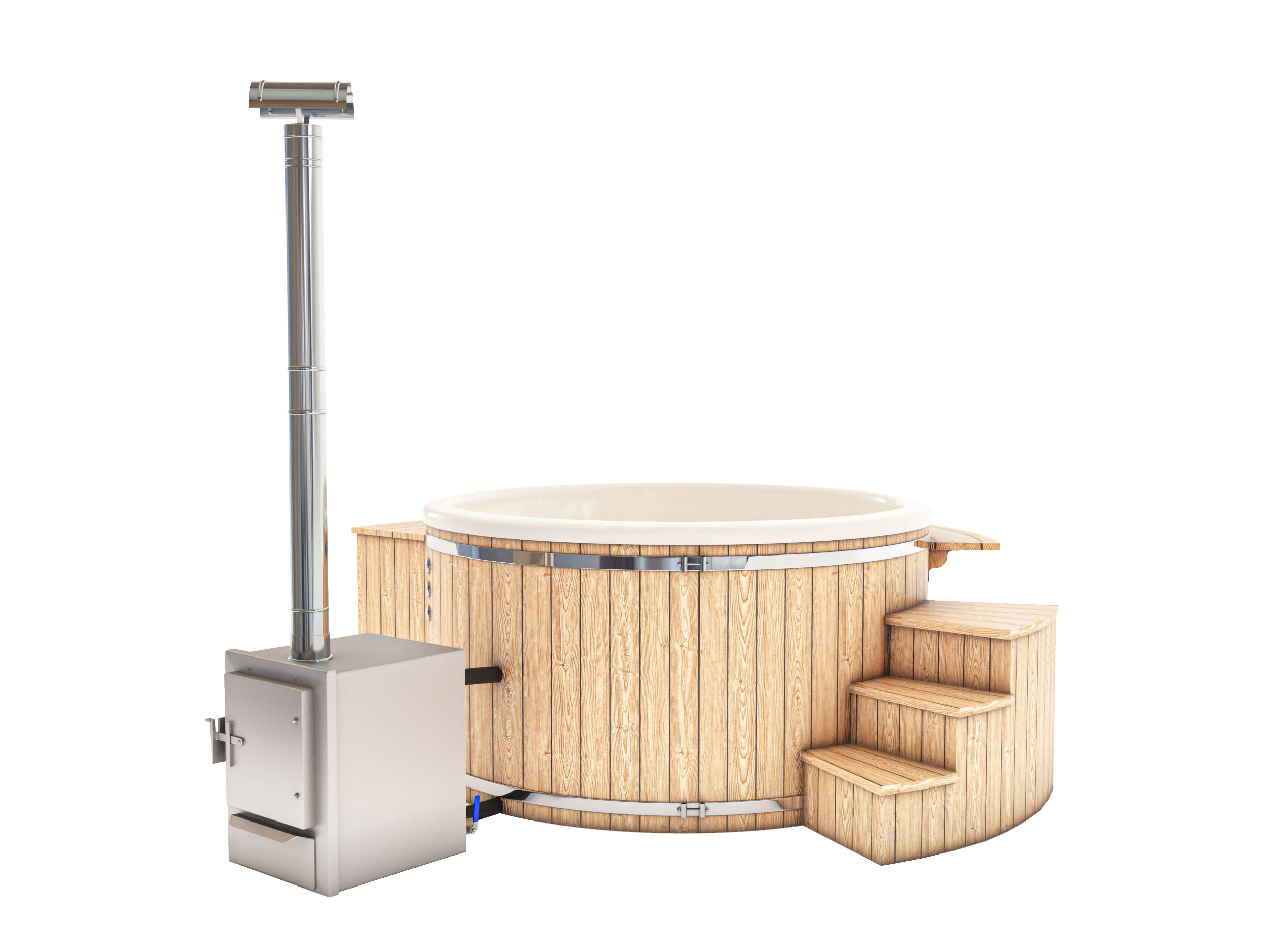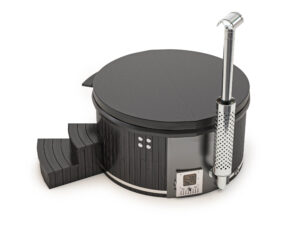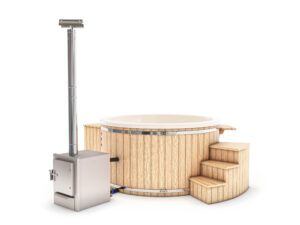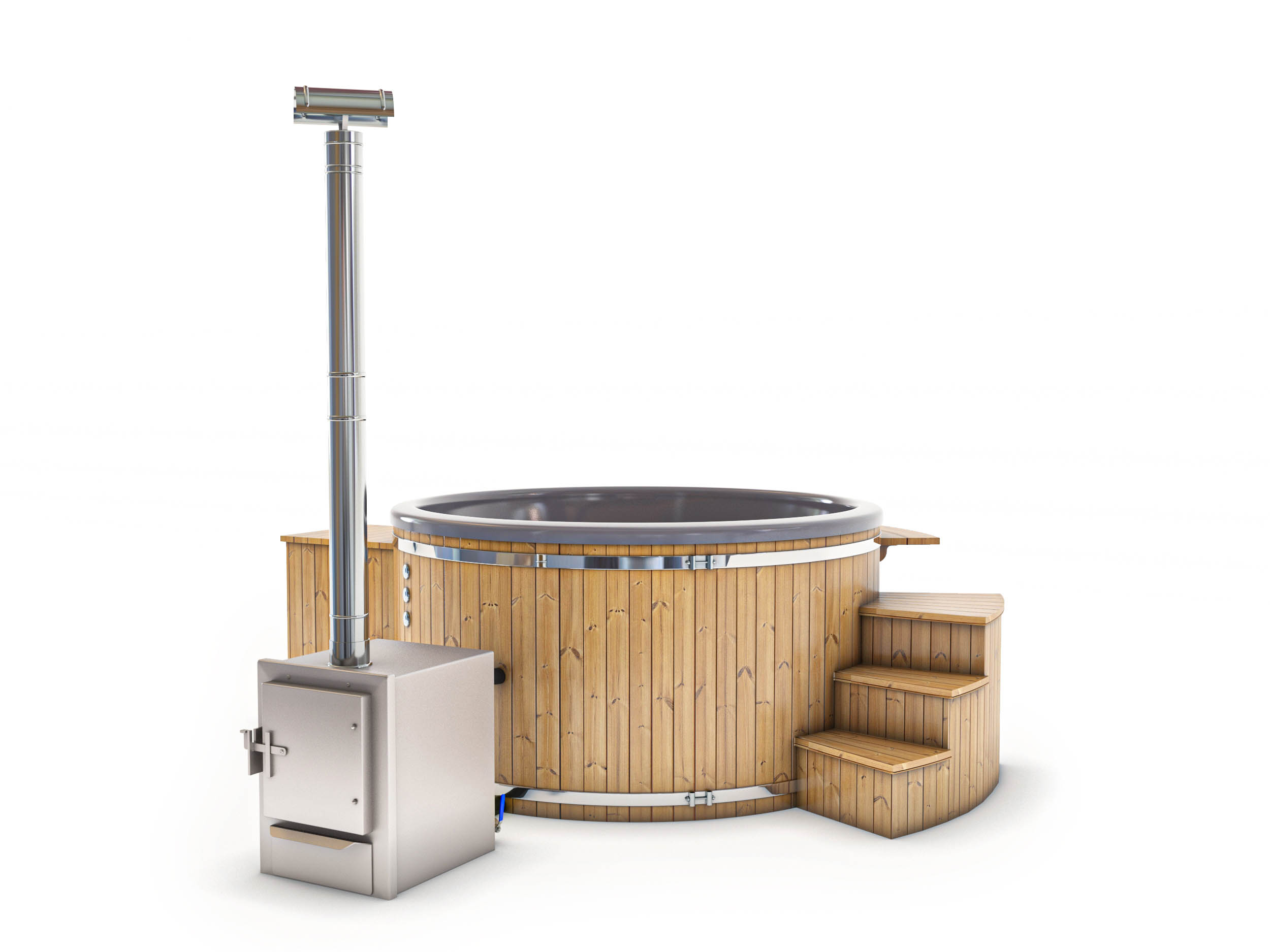Ultimate Wood Fired Hot tub Guidelines
User Manual and Safety Guidelines
User manual and safety guide Contents
IMPORTANT SAFETY INFORMATION
The safety of your Wood Fired Hot Tub is our utmost concern. This hot tub is designed for personal and commercial use but with several limitations for public or commercial purposes. To ensure a safe and enjoyable hot tub experience, we strongly recommend adhering to the following safety precautions. Ensure you understand these instructions before installation and use:
Child Safety: Children must not have unsupervised access to the hot tub. Monitor children at all times to prevent accidents.
- Lower water temperatures are suggested for young children, as their skin is more sensitive to hot water.
- Remind children about the slipperiness of wet surfaces to avoid accidents while entering or exiting the hot tub.
- Do not allow children to climb onto the thermal cover, or to dive or jump into the hot tub from the outside.
Diving Prohibition: Avoid diving into the hot tub. This action can lead to serious injuries or even death.
Thermal Lid: Your Wood Fired Hot Tub comes with a thermal lid, it meets the standard for protective covers. Ensure the lid is always locked post-use for the safety of children.
Water Temperature: Always test the water temperature manually or with a thermometer before allowing anyone to enter the hot tub. Ensure the temperature is comfortable to prevent scalds or burns.
Unattended Access: Unauthorized and unsupervised access to the hot tub should be strictly avoided.
Suction Grate: Do not remove the suction grate from the water pump to mitigate the risk of injury. The hot tub’s jets produce powerful suction, and damaged covers can pose a risk to young children and adults with long hair. If any body part is drawn into these fittings, immediately shut off the hot tub. As an additional safety measure, individuals with long hair should tie it up.
Remember, safety is paramount when enjoying your TenSpa Hot Tub. Always practice caution and ensure these guidelines are followed.
Electrical Safety Instructions
Your Wood Fired Hot Tub requires electrical connections for operation. Strict adherence to the following safety instructions is essential to prevent accidents, electric shocks, or potential damage to the tub:
Electrical Setup: Ensure that all electrical connections and cables are situated away from water. Connect the hot tub only to a grounded power source.
Power Cord Safety: Never bury the power cord. Improper installation or use of unsuitable cables can cause severe injury or death from electric shock.
Servicing: Do not attempt to service the product yourself. Contact qualified service personnel if:
- Power supply cables are damaged.
- Water penetrates into the electrical equipment area.
- The shield exhibits signs of damage.
- There’s other potentially hazardous damage to the equipment. In such scenarios, immediately disconnect the device from the power source.
Damaged Cord: Replace any damaged cords immediately to reduce the risk of electric shock.
Installation Proximity: Install the hot tub at least 1.5 meters away from all metal surfaces. However, a smaller distance is acceptable if all metal surfaces are permanently grounded.
Electrical Devices: Do not place any electrical devices (like lamps, telephones, radios, or televisions) within 1.5 meters of the hot tub. This can cause electric shock if the device accidentally falls into the tub.
Drain Location: Install the hot tub so that the water drain is distanced from the maintenance hatch and all electrical components.
Proper Connection: Ensure the hot tub is correctly connected to the power supply, preferably by a licensed electrician.
Maintenance and Servicing: Always unplug the hot tub from the power supply before draining or servicing the electrical components. Never use the hot tub with the maintenance hatch open.
Extension Cords: Do not connect the hot tub to a power source using an extension cord. It may not be properly grounded and can cause voltage drop, overheating, and damage to the jet pump motor.
Electrical Switch Box: Never attempt to open the electrical switch box as it does not contain any user serviceable parts.
By following these guidelines, you can ensure a safe and enjoyable hot tub experience.
General Safety Information
The Wood Fired Hot Tub is designed for relaxation and leisure. However, it’s essential to adhere to the following guidelines to ensure a safe hot tub experience:
Water Temperature: Before entering the hot tub, check the water temperature using an accurate thermometer. The water temperature should never exceed 40°C (104°F). A safe range for healthy adults is between 36°C and 40°C. Prolonged use (more than 10 minutes) and young children should be in cooler water.
Hyperthermia: Extended immersion in hot water may lead to hyperthermia, where your internal body temperature exceeds the normal 37°C. Symptoms include health threat unawareness, inability to perceive heat, failure to recognize the need to exit the tub, physical incapacity to exit, unconsciousness, and in pregnant women, potential fetal damage.
Pregnant Women: Pregnant or potentially pregnant women should limit hot tub water temperature to 36°C and duration of use. It’s recommended they consult a doctor before use, as excessive water temperatures early in pregnancy can result in fetal damage.
Post-Exercise: Do not use the hot tub immediately after rigorous exercise.
Suction Fittings: Ensure suction fittings match the specific water flow of the pump. Never replace them with fittings that have a lower flow rate.
Slip Hazards: Wet surfaces can be slippery. Be cautious when entering or exiting the hot tub, especially in frosty weather.
Suction Fittings: Do not operate your hot tub if suction fittings are missing or damaged.
Health Concerns: People with infectious diseases, open wounds, or similar should not use the hot tub. Warm and hot water can encourage germ growth if not properly cleaned.
Medication and Alcohol: Consuming alcohol, drugs, or certain medications before or during hot tub use can cause unconsciousness, increasing the risk of drowning. Consult a doctor before use if you are on medication that can induce drowsiness or affect heart rate, blood pressure, or circulation.
Medical Conditions: Individuals with obesity, heart disease, high or low blood pressure, circulatory problems, or diabetes should consult a doctor before using the hot tub.
Cold Weather: In cold weather, consider wearing a bathing cap to avoid catching a cold.
General Wellness: If you’re not feeling well or are tired, refrain from using the hot tub. Prolonged hot baths can lead to fluid loss, which, in severe cases, can cause heat stroke.
Always ensure you’re in a good health condition and follow these guidelines to enjoy your hot tub experience safely.
Getting Started With Wood Fired Hot Tub
First Steps
The Wood-Fired Hot Tub is designed exclusively for private outdoor use. Adhere to the following guidelines during the initial setup:
- Transportation and Installation: The hot tub is delivered upright, placed on a pallet for transportation purposes. This pallet should be removed before the final installation. Bring the hot tub into a horizontal position as soon as possible after transportation to prevent it from bending into an oval shape. Always lift the hot tub from the base, not by the edges of the tub.
- Assistance: For any questions related to the setup, operation, or maintenance of your hot tub, reach out to your authorized Wood Fired Hot Tub dealer. These professionals are well-versed with the product and can expedite your journey towards enjoying your new Wood-Fired hot tub.
Assembly
Preparing the Subsurface
The proper placement and preparation of the subsurface are crucial to the safe and efficient operation of your hot tub:
- Level Surface: The hot tub should be placed on a level surface capable of supporting the weight of a fully filled hot tub (approximately 1600-1900 kg, depending on the model). The ground can be leveled with gravel, or for a more stable base, you can use concrete or stone slabs.
- Vegetation: Remove all vegetation beneath the hot tub to prevent it from penetrating the hot tub structures as it grows.
- Ventilation and Protection: Ensure that the hot tub is not surrounded by tall grass or shrubs, which can hinder wood breathing and promote rot. If your hot tub has a wooden substructure, ensure it’s not permanently exposed to moisture, which could cause decay and infestation by decomposing organisms.
- Location and Accessibility: Choose a location that facilitates potential maintenance measures. The hot tub should always be relocatable if necessary, even if it’s embedded in a terrace. The warranty does not cover indirect costs such as dismantling or rebuilding a terrace.
These guidelines ensure your Wood Fired Hot Tub is safely installed and ready for use. Enjoy the luxurious experience it offers!
Water Drainage
The hot tub features a 1″ ball valve on the lower right-hand side of the stove, functioning as a water drain. For models measuring 2 meters with an external stove, an additional drain is located in the hot tub floor.
Select a location for your hot tub where the water can be easily drained. If you prefer to drain the water via a hose, a 1″ (inch) connection nipple will be needed for hose attachment (not included).
Fire Safety
If the hot tub is situated near a building, such as at the edge of a terrace, it is essential to ensure that the chimney is sufficiently distanced from any combustible materials. This distance needs to be verified both laterally and vertically to avoid any fire risk. The top of the chimney must maintain a minimum distance of 3 meters from flammable materials. From other parts of the chimney, smaller side distances are permissible.
If the prescribed safety distance cannot be maintained, use an insulated chimney (sold separately). In cases where the chimney is near the roof or penetrates it, the end of the insulated part should protrude at least 1 meter above the roof.
Avoid placing any flammable materials in front or beneath the combustion chamber. This area should only contain non-combustible materials like concrete, sand, or a metal plate, as indicated in the illustration. While the entire combustion chamber is surrounded by water, limiting the stove temperature to the water’s temperature, the stove hood and hatch will become hot. For more detailed information, please consult your local fire safety authority.
Connecting wood fired hot tub heater/oven
For effective operation, the outdoor oven and the hot tub must be positioned on the same level. While connecting the outdoor oven, ensure the upper connection hose from the oven runs diagonally up to the hot tub. However, the lower connection hose may run directly to the hot tub.
First Use
Prior to the first use, the water circuit of the furnace needs to be flushed. This can be achieved by spraying an ample amount of water into the topmost pipe with a hose, thereby flushing out any residues from the furnace. Any dirt or debris that accumulates during this process can be removed from the bottom of the hot tub. While the hot tub is in operation, periodically check the furnace connection pipes for any leaks to ensure efficient and safe use.
Filling Wood Fired Hot Tub For The First Time
When filling the hot tub, you should consider the number of people who will be using it. More people in the hot tub displace more water, which means less filling is required. If the hot tub is expected to be used with the maximum number of people, it is advisable to only fill it to the minimum level. Before filling, make sure that the hot tub’s drain ball valve is closed.
Minimum Fill
The hot tub must always be filled to at least 5 cm above the upper connecting pipe of the oven before heating the oven! The water-filled oven must not freeze in winter. To prevent this, the hot tub should be emptied before freezing temperatures set in, or you must ensure sufficient heating of the water. The furnace should not be connected to a circulation pump; it is only designed for automatic gravity circulation.
Warning for Oven Heating
Never fire up the hot tub oven if the hot tub is empty or insufficiently filled with water. Doing so will always result in the furnace melting and becoming damaged! Similarly, the hot tub should not be emptied before the fire in the oven has completely gone out and the embers have cooled down.
As the water heats, it will stratify, meaning it must be consistently mixed manually during heating to accurately determine the real water temperature. If available, the thermal lid should be used to reach the target temperature more quickly when heating the water.
Frost Precautions
Always be mindful of the water in the hot tub when there is a risk of frost. Under no circumstances should the water be allowed to freeze. In such cases, either briefly reheat the hot tub and ensure that the water-filled hoses are rinsed regularly (every 15 minutes), or drain all the water out of the hot tub. If draining the tub, all ball valves including the filter connections must always be half-open so that any water entering from the outside drains off by itself and cannot freeze due to frost.
To remove the last bit of water from the lines of the hydro or air massage system, let both functions run briefly (for a maximum of 20 seconds) after all the water has been drained.
Two ring clamps for 19mm keys are located on the outer edge of the hot tub near the furnace. These clamps are used to tighten the stainless-steel rings. If the wooden boards loosen while drying, you can tighten the rings, but don’t overdo it as this can damage the wood.
If a lid is used to cover the hot tub, it should be placed on a clean surface and away from the floor when not in use, to prevent contaminants from entering the hot tub.
Lighting the Stove and Heating
Using the stove is straightforward – it’s like using any other fire pit. Start the fire with small, dry logs, and then gradually add larger logs every 10-15 minutes. Ensure that the stove is fully heated so that the wood burns properly and the hot tub is heated at maximum power. If the fire is too small, the heating time will be significantly extended.
Follow the instructions when using ignition fluid, and never use fluids that aren’t designed for lighting. It’s recommended to use lighter cubes for lighting, such as burner paraffin bags.
Condensation often forms in the combustion chamber due to the temperature difference between cold water and warm air. This is a physical effect and does not indicate a leak in the furnace. A decrease in the water level in the hot tub might suggest a leak.
Only use dry logs that have been split into small pieces as fuel for the stove. Large and damp logs can double the heating time and produce heavy smoke. Adjust the stove’s air supply according to the type of wood and log size to reduce smoke. Do not use coal as fuel as the high burning temperature can damage the stove.
After each use, empty the ash from the ash pan and the combustion chamber. Components such as grates and air flaps are consumables and are not covered by the warranty.
Ensure that the stove’s inlet and outlet connections aren’t covered. Without constant circulation, the water inside the stove can overheat, causing damage.
Cover the hot tub during heating to minimize heat loss, and check the water temperature every 20 minutes. As water stratifies during heating, stir it before measuring the temperature to avoid overheating and potential burns. As the temperature reaches around 32 degrees, use less wood to prevent unnecessary overheating. Once the desired temperature is reached, maintain a small fire to keep the hot tub warm, if needed.
Caution: Risk of Burns! Hot water flows out of the stove’s outlet.
Remove the lid about 5 minutes before bathing to let the water “breathe”. Close the lid quickly after bathing to ensure safety and reduce heat loss, especially if you plan to use the hot tub the next day.
Hot Tub Care and Safety
Cover the hot tub when not in use to keep dirt out. You can use the available accessory lids for this purpose. It’s also advisable to keep the hot tub covered while heating it to minimize heat loss.
Wood fired hot tub Surface & Cladding Treatment
Thermo Wood
Hot tubs covered with thermo wood have a beautiful brown shade. To retain this color, it’s necessary to treat the hot tub’s exterior with a UV-protective impregnation at least once a year. At the factory, hot tubs are treated with water-based wood oil. A new treatment with an appropriate wood preservative and a brown shade of your choice is recommended. Wood-fired hot tub feature sustainable LUNAWOOD thermal wood, produced through a natural process involving high temperatures and steam. The thermal modification improves the wood’s properties and greatly expands its potential applications. Thermo wood is dimensionally stable, rot-resistant, and resin-free. It’s suitable for indoor and outdoor use in any climate. Lunawood is a non-toxic, natural wood that’s easy to work with.
WPC (Wood-Plastic Composite)
Composite panels and recycled plastic are highly resistant to wear and tear, moisture, and stains. Their surface doesn’t splinter. These materials tolerate UV radiation, which prevents them from graying quickly. Both materials are easy to maintain and require no treatment other than occasional washing. Due to the recycled material used for the panels, there may be color differences and irregularities in the surface.
Additional Guidelines
Ensure that the drain ball valve in the empty hot tub is always at least half-open. If water gets into the hot tub and the drain is closed, the water in the plumbing can freeze and cause damage.
All ball valves are fitted with a safety device that prevents accidental opening or closing. To activate this, push the safety device towards the handle. The lever can then be moved freely.
The outdoor oven should be drained at the same time as the hot tub. Do not leave unheated water in the hot tub if there’s a risk of frost. The metal or plastic pipes and the ball valves can freeze easily. If the oven’s drain ball valve is frozen, the hot tub can only be emptied after dismantling the oven. The water can then be drained from the lower connecting hose. If the water is frozen in the oven, do not light a fire! The oven needs to thaw slowly.
The hydromassage system should only be activated when the intake port in the hot tub is covered with water, to prevent the pump from running dry. Also, ensure that the intake port isn’t covered when the hot tub is being filled.
Hygiene - Water Treatment For Wood Fired Hot Tub
When it comes to public use, you must use chemicals that can kill bacteria, typically chlorine. For household use, you have the option of using oxygen-based chemicals for disinfecting small pools. The dosage instructions for these chemicals are found on the packaging and must be adhered to. Overdosing can lead to corrosion of parts of the hot tub.
Caution! When using chemicals, it’s critical to continually monitor the pH level of the water and keep it within the prescribed range of 7.0–7.6. Usage of chemicals often causes the pH level to drop, which can lead to corrosion of parts of the hot tub. The use of trichlorine-based tablets or other tablet combinations is prohibited in the hot tub. This prohibition does not apply to 20 g tablets, whose concentrations cannot rise excessively. Use only chemicals recommended by the manufacturer.
Chemicals in tablet form should always be dissolved with a dispenser in the hot tub and never be added directly to the hot tub.
To make the same water last longer, you need to use chemicals in conjunction with filters and possibly other cleaning devices. Only this combination can keep the water clean and hygienic for an extended period. You can inquire about filters and chemicals at specialist stores.
Chemical dosing devices designed for swimming pools should not be used with these low-water hot tubs. These devices often lead to overdosing and can easily cause material corrosion. Automatic chemical dosing devices must also be constantly monitored, and the pH level of the water and other parameters should be measured regularly.
If the hot tub is filled with water for exhibition or presentation purposes, the water must always be chemically treated.
Always keep the water clean and disinfect it with the right chemicals. The recommended values for your Wood fired hot tub are:
- Free chlorine: 1.0–5.0 ppm
- Total alkalinity: 40-120 ppm
- Water pH: 7.2–7.8
- Calcium hardness:
- Standard: 75-150 ppm
- Salt systems: 25-75 ppm
Click here to see what SPACARE Recommends, you will be directed to an external resource.
Hygiene for Wood Fired Hot Tubs Without a Filter System
When a hot tub does not have a filter system and there’s no other water exchange mechanism, the water should only be used for one bath and then drained.
If you’re using drinking water (in compliance with the drinking water regulations of the country in which it is used), the maximum lifespan of the water is 5 hours.
If you’re using untreated water without drinking water properties (as per Directive 2006/7/EC), the maximum lifespan of the water is 3 hours.
This ensures the water in your hot tub remains as hygienic as possible, minimizing the potential for contamination and related health risks. Always ensure to properly clean and maintain your hot tub to maximize its lifespan and maintain a healthy bathing environment.
Maintenance of a Hot Tub with a Hydro or Air Massage System
A hot tub with a hydro or air massage system offers a great experience, but it requires specific care and maintenance, especially in the winter months. Here’s how to maintain it:
Cleaning the Hot Tub: Always keep the hot tub clean and hygienic by washing and drying it regularly. After each use, rinse the oven and pipes of the hot tub. You can clean it with a mild detergent and a soft cloth (do not use scratchy sponges or abrasive cleaners!). After cleaning, leave the drain tap open so that all the water can drain out of the pipes.
Using the Hydro or Air Massage System: The hydro massage system uses a powerful water pump to drive six jet nozzles for a targeted massage effect, while the air massage system uses a special pump to blow air currents into the water through 15/16 ventilation openings. Remember, do not put your fingers in the jet nozzles to avoid injury.
Use of a Hot Tub with Hydro or Air Massage System in Winter: Winter requires special attention. All hoses and nozzles must be protected against freezing. If the pumps are out of order and the hot tub contains water, the hoses will fill with water. Ensure you start the pumps at least every 15 minutes to prevent the water in the hoses from freezing.
When draining the hot tub, briefly start the pumps to remove the water in the hoses. Drain the water from the hot tub and repeat the process at least three times to ensure no water is left in the hoses.
Frost Warning! When the hot tub is empty and there is a risk of freezing, it is crucial that no water remains in the system. Start the pumps with the hydro or air massage system installed and let them run for about 5 seconds. Repeat this process three times to ensure all water has been expelled.
It's time to unwind in a wood-fired hot tub!
-
Smart Wood fired hot tub Mobile control
£5,285.74 – £6,176.74 Inc VAT And ShippingSelect options4-5 person Hot tub with smart heater
-
Daintree ex Wood Fired Hot Tub
£3,450.34 – £4,836.10 Inc VAT And ShippingSelect options6-8 Person Hot tub with external heater
-
Daintree Wood Fired Hot Tub
£3,532.70 – £4,918.46 Inc VAT And ShippingSelect options6-7 Person Hot tub with internal heater
-
Tarkine ex Wood Fired Hot Tub
£3,114.00 – £4,321.30 Inc VAT And ShippingSelect options4-6Person Hot tub with external heater
-
Tarkine Wood Fired Hot Tub
£3,340.51 – £4,547.81 Inc VAT And ShippingSelect options4-5 Person Hot tub with internal heater

